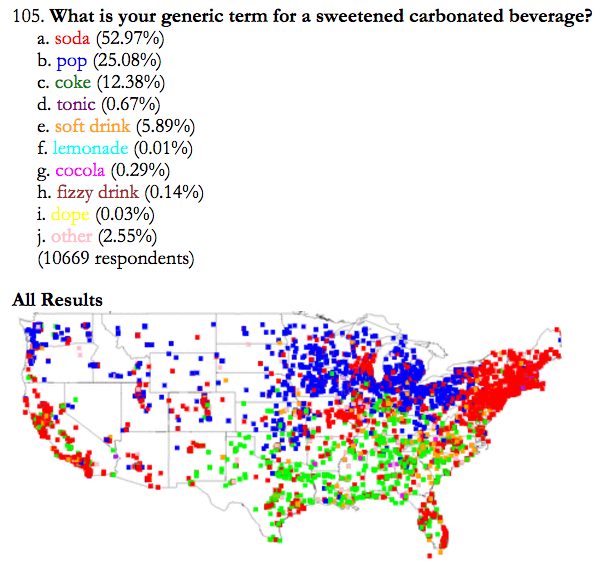Quick links
pop
DCHP-2 (Oct 2012)
n. — Food & Drink
any carbonated, sweetened, non-alcoholic beverage (e.g. Coke, Pepsi, Sprite, ginger ale).
Type: 5. Frequency — Pop is the most common generic term for carbonated beverages in Canada, with the exception of Quebec (see soft drink and Chambers & Heisler 1999:42-43, Boberg 2010: 178 and passim). The OED-3 (s.v. "pop" (n.1 (6)), 1812 quotation) shows the term is originally British and suggests that the name originates from the sound made when the cork leaves the bottle. As Image 1 shows, from the 2004 Harvard Dialect Survey of the United States, soda is the majority variant there, with pop a distant second. The function of pop in Canada is quite different. Boberg (2010: 172) writes:
"The frequency of pop reaches 100 percent in interior British Columbia, over 90 percent across the Maritimes (despite its absence across the border in New England), and over 85 percent in southern Ontario, Alberta and Vancouver-Victoria".
Its main competitor in Canada is soft drink, which is used "both in and outside Montreal (73 percent), where pop is rare (4 percent). Soft drink also intrudes on the dominion of pop in Manitoba (32 percent), eastern Ontario (38 percent) and Newfoundland (27 percent), though pop is somewhat stronger in these regions."
Despite US distributions as shown in Image 1, pop must therefore be considered the prime Canadian variant outside Quebec. As Boberg (2010: 173) further shows, soda, "the main term in the northeastern and southwestern United States, and coke [used generically as the term for any carbonated sweet beverage], the main variant in the American South, enjoy virtually no currency in Canada," unless in their specialized meanings (i.e. as a term for for soda water.) Pop is significant in Canada due to its dominance in most of the country, while the term most prevalent in the northeastern and southwestern US, soda, has virtually no currency in Canada (see Boberg 2010).
"The frequency of pop reaches 100 percent in interior British Columbia, over 90 percent across the Maritimes (despite its absence across the border in New England), and over 85 percent in southern Ontario, Alberta and Vancouver-Victoria".
Its main competitor in Canada is soft drink, which is used "both in and outside Montreal (73 percent), where pop is rare (4 percent). Soft drink also intrudes on the dominion of pop in Manitoba (32 percent), eastern Ontario (38 percent) and Newfoundland (27 percent), though pop is somewhat stronger in these regions."
Despite US distributions as shown in Image 1, pop must therefore be considered the prime Canadian variant outside Quebec. As Boberg (2010: 173) further shows, soda, "the main term in the northeastern and southwestern United States, and coke [used generically as the term for any carbonated sweet beverage], the main variant in the American South, enjoy virtually no currency in Canada," unless in their specialized meanings (i.e. as a term for for soda water.) Pop is significant in Canada due to its dominance in most of the country, while the term most prevalent in the northeastern and southwestern US, soda, has virtually no currency in Canada (see Boberg 2010).
See: soft drink
As the 1932 quotation demonstrates, pop has a long history in Canada.
Quotations
1932
The arrests of both men were made after Constable Wilson, being driven in a car, had pursued a five-ton soft drink truck, driven by Legger, which was swerving about the street in such a dangerous manner, police said, five cases of bottles were thrown from the truck and the machine was about to be driven from Shuter Street onto Yonge Street, when the constable, jumping from the car to the running board of the truck, reached his arm in and turned off the ignition, stalling the truck. [...]Legger and Packwood, police allege, had been drinking wine, and after sampling some of the “pop” from the truck, climbed into it and Legger drove it away.
1951
A friend of all the children in the district, Pogo [a duck] was quite tame. He loved crowds. He would take food out of a child's mouth or drink pop straight from the bottle.
1965
The first four stores they visited charged 11 cents for pop. In a coin laundry they found a machine that required only a dime.
1978
Toronto school board trustees who banned junk foods in high school cafeterias should look inside their own refrigerator. Yesterday, the refrigerator in the trustees' lounge was packed with 30 bottles of pop, two small tins of tomato juice and four cartons of milk. Upstairs at the entrance to their cafeteria is a pop machine and a chocolate bar machine.
1984
Such is the great pop can controversy in Ontario. The Government has been fiddling around with the regulations on soft-drink containers for more than a decade, and is about to make another change.
2008
Streets, parks and sidewalks are littered with pop cans, drink boxes, plastic utensils, Slurpee cups, fast-food containers and candy wrappers. I pondered this while walking and thriftily collecting other people's empty pop and alcohol cans to recycle, as usual. The root cause of the obesity and littering problems is that the public appears to have adopted the eating and lifestyle habits of a 10-year-old whose parents are permanently out of town.
2016
Foods such as refined carbs, pop and white rice spike our blood sugar, and increase the risk of obesity and insulin resistance, which hinder fertility. A 2012 study from Boston University School of Public Health found women who drank lots of pop had lower chances of conceiving.
Not sure what's high on the GI index? Avoid products that list sugar as their first ingredient.
Not sure what's high on the GI index? Avoid products that list sugar as their first ingredient.
References
- Chambers & Heisler (1999)
- Boberg (2010)
- OED-3
- Vaux (2004) • #105 pop/soda
Images
